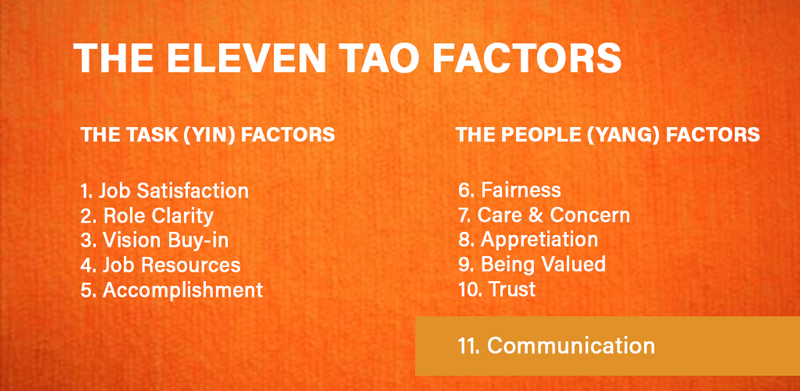Unit 2 Employee Loyalty

Photo by Andrea Piacquadio from Pexels
Overview
During this unit, you will be introduced to the concept of loyalty and its relationship with employment engagement. Why is loyalty important for employee engagement? What is the definition for employee loyalty? What are the factors involved in Tao of loyalty?
This unit is divided into the following topics:
- The Fifth P of marketing;
- The Tao of Loyalty;
- Loyalty Segmentation;
- The Eleven Tao Factors.
Learning Outcomes
When you have completed this unit, you should be able to:
- Assess the effectiveness and shortcomings of an organization’s engagement and stewardship practices.
- Utilize best practices to foster employee loyalty within an organization.
- Differentiate between the emotional and behavioral factors of Employee loyalty.
- Measure work engagement based on vigor, dedication and absorption.
- Understand Walker’s emotional and behavioral loyalty level measuring tool to help organizations assess employee loyalty.
2.1 The 5th “P” of Marketing
As the world changes and businesses develop, there have been significant changes in the market and business / healthcare operations in recent years. A notable change is the structure and environment of organizations. As a result, the boundaries of the industry have been redrawn, which has not resulted in a clear definition for some industries.
Today’s technology, such as the Internet, mobile phones, and constant access, has changed the way business is conducted, how communication occurs, and how decisions are made. Furthermore, in recent years it has been evident that with the economic crises and the recent health crises, organizations have been forced to adapt in order to survive the chaos.
Companies, have been affected by culture from the outside in, which has required leaders to reveal in a transparent manner what the organization believes. This transparent approach must be followed by adaptation of new strategies and thoughtful actions.
Clients, patients and consumers have also changed, and these changes have been accompanied by organizations that have adapted to these changes, and with some of the new communication channels it is evident that they are very different from the previous decade in many ways:
- They are far more educated and knowledgeable.
- They know what they want, they know what is available, and they know where to get it.
- They are more aggressive and assertive. much less passive.
They are more aware of their (purchasing) options, and power.
As a result, businesses and organizations are forced to be more creative and innovative to not only get the customer/patient but to keep them as loyal customers/patients. Traditionally, businesses have paid close attention to the Four “P”s of Marketing to earn and keep their fair share of the market. The four “P”s being:
- Product
- Place
- Promotion
- Price
So… What is the fifth “P”?
With the fast-changing market, these are no longer adequate to run and grow a business. Ajit Rao, in his book, ”The Tao of Loyalty” (2006), suggests a critical fifth “P” - People, be added to the list, and that it needs to take precedence over the other four “P”s of marketing. As the world gets smaller, technology and innovation are now available to the masses. Our people, our truly loyal employees, are the key for organization to distinguish themselves in the marketplace.
Rao suggests “great experiences” are now critical in building customer/patient loyalty. The other four “P”s may bring the customer/patient in, but it will be their experience that will keep them. This “great experience” cannot happen without highly committed and loyal employees and every level of the organization.
Keeping loyal employees requires understanding their needs and wants, setting targets, and measuring their engagement levels. Thus, customers, management, and the staff are all considered to be part of the People element.
Learning Activity: Rate your work engagement - UWES
- For this learning activity please read chapter 1 of textbook (Peters, 2019), pp. 23 - 24.
Background: Schaufeli, Bakker and Salanova developed a questionnaire to measure work engagement, the Utrecht Work Engagement Scale (UWES). The 20 questions that follow are based on their three aspects of engagement: Vigor, dedication, and absorption.
2.2 The Tao of Loyalty
An organization’s key challenge is measuring, developing, and managing its employees’ loyalty. “Employee loyalty” is composed of two key elements: Emotional and Behavioral. Often, it begins with a cognition of the organization’s vision and mission.
Emotional: The employee’s attitude and psychological feeling towards the organization. (internal)
Behavioral: The employee’s actions and/or reactions to an object or event. (external)
This is where Rao introduces his concept of the Tao of Loyalty. The Tao is a school of Chinese philosophy that teaches that life is full of contradictions, such as male and female, hot and cold, soft and hard. It is through understanding these contradictions that one can better manage and respond to life. Employee engagement within organizations is an understanding of the contradiction between the emotional and behavioral aspects of loyalty. Using the Tao of Loyalty concept, Rao measures and manages the loyalty levels of their employees.
“Those employees who feel emotional contentment in the workplace, feeling of doing one’s personal best to address the organization’s concerns as one’s own, a feeling of pride that the organization brings out the best in them as individuals as well as professionals, and are also willing to stay in the organization for longer periods of time” (Rao, 2006, p. 39)
Emotional Loyalty Behavior
Employees who are emotionally loyal stay with an organization because they enjoy what they do, feel productive, and believe their workplace is a nurturing environment. Such a person will go out of their way to promote the organization as a great place to work and to attract customers/patients and other potential employees. Their commitment to the organization will make them a valuable employee and an effective marketer for the company.
Non-loyal employees erode brand equity and drive customers/patients away. A front-line employee can have a significant impact on an organization’s bottom line. They will leave the organization quickly and easily and they will strongly advocate to potential customers/patients and employees that the organization is a bad place to work.
2.3 Loyalty Segmentation
Source: (Reading – Rao, 2006, p. 63) also read (Peters, 2019, pp. 33-35)
Emotional loyalty and the resulting behavior are a very powerful influence on an organization/business as well as an indicator of its health and its future potential. Consequently, an organization/business should be able to know what those indicators are and be able to measure employee loyalty.
Walker Information (1994) created a tool that measures the emotional and behavioral loyalty levels of employees in an organization and places them on a matrix that allows the organization to assess their overall employee loyalty.
Employees are placed in one of four quadrants:
- High/High (I) -Truly Loyal: Happy, fulfilled, settled employees:
They are emotionally and behaviorally loyal to the organization. They come to work because they want to and desire to continue to work in the organization. They are very positive about the organization both internally and externally. The organization needs to have most of its employees in this quadrant.
- High/Low (II) -Accessible: Value-seekers, opportunists’ employees:
They are emotionally loyal to the organization but in behavior, they are likely to leave shortly at the first chance for something perceived to be a better opportunity or with greater value to them. Some of it can be due to organizational issues, but most there are external influences.
- Low/High (III) -Trapped: Unhappy, unmotivated, fearful employees:
They are not emotionally loyal to the organization, but they will not leave the organization. They usually are minimum contributors to the organization, to prevent being fired. They are not motivated or productive, are unhappy but will not move out due to fear. Fear of the unknown, change, loss of income, age considerations, debt load, etc. Their unhappiness, lack of motivation, and productivity cost the organization.
- Low/Low (IV) -High Risk: Disillusioned, already gone in their heads.
They are not emotionally loyal to the organization and have no desire to stay. The organization has disillusioned them and they are ready to leave at any moment. It is a high-risk for them to leave, as well as a high-risk for the company while they are still working there.
Segmenting customers in this way is very practical and flexible. To improve business performance in each of these quadrants, specific action plans can be developed.
2.4 The Eleven Tao Factors
Rao (2006) proposes that eleven key factors should be managed in order to establish and maintain a high percentage of loyal employees. Rao introduces a simple quiz to get a quick sense of an employee’s loyalty level.
The percentage of employee loyalty will be high if the organization scores highly with all eleven factors.
Job Satisfaction, Role Clarity, Buy-in to Vision/Mission/Values, Resources, Accomplishments, Appreciation, Valued, Fairness, Trust, Care, Concern, and Communication make up the 11 key factors.
These eleven factors fall into two categories, Task-oriented and People-oriented. They represent the yin and yang of employee loyalty that must be understood, addressed, and managed in order to produce truly loyal employees.

Image by: Mara Chequer
In the new and fast-changing marketplace, organizations must make the fifth “P” -People, specifically their employees a high priority to succeed. Identifying, measuring, and understanding their Employee Loyalty Levels is a critical first step.
Rao believes that Employee Engagement and Employee Emotional Loyalty are two sides of the same coin. Both are measurables of how to get the best out of each employee. However, there are two significant differences worth noting:
- Engagement focuses on effectively engaging the employee in the workplace, thereby getting the most efficiency out of them, making them more effective for the organization. Rao (2006) calls this an “inside-out view, focusing on the employee first. Emotional Loyalty focuses on the organization from the employee’s perspective, asking “Why should the employee feel bonded with the organization?” Rao says this is an outside-in view.
- If engagement is a selfish view where the organization is asking, “How can I get the best out of my employee?
In the case of emotional loyalty, the question is asked from the perspective of, what should I do to create a highly positive and nurturing environment for the employee, so that they will give everything they have to the organization? Creating and nurturing Employee Emotional Loyalty is in keeping with the values and practices of Transformational Servant Leadership (TSL). An organization’s employees carry out its mission and vision every day. They are instrumental to the organization’s success.
If you are interested in the knowledge/understanding of TSL values and practices, you can consult materials from LDRS 500 and MA in Lead Resources on Moodle.
Summary
The construct of employee engagement consists of personal and professional components (Truss, Delbridge, Alfes, Shantz, Soane, 2014). A combination of “job satisfaction, job involvement, and affective organizational commitment” (Newman et al., 2010). Despite relational contexts being undervalued in employee engagement practices, employee engagement thrives in some relationships and wilts in others. “Relationships affect how work gets done –how individuals and teams coordinate, share knowledge, and accomplish tasks” (Bechky, 2006, as cited in Truss et.al., 2014).
The relational dimensions of personal engagement at work include meaningfulness (deepened purposes and heightened belongingness), safety (holding environments and group patterns of interaction), and availability (energizing and high-quality connections and interactions, emotional relief, and depletion (to feel for themselves and others).
Truss et.al. (2014) also point out that three constructs are highly associated with employee engagement: engagement, burnout, and workaholism. In Schaufeli’s study (2008), he showed that rather than being three of a kind, workaholism, burnout, and engagement are three different types of employee well-being factors.
References
- Peters, J. (2019). Chapter 1. Employee engagement: Creating high positive energy at work (eBook). KR Publishing company.
- Bridger, E. (2018). Chapter 1. Employee engagement: A practical introduction. Kogan Page Limited.
- LDRS 617 W2 mini-lecture notes. Unpublished manuscript. Master of Arts in Leadership. Trinity Western University.